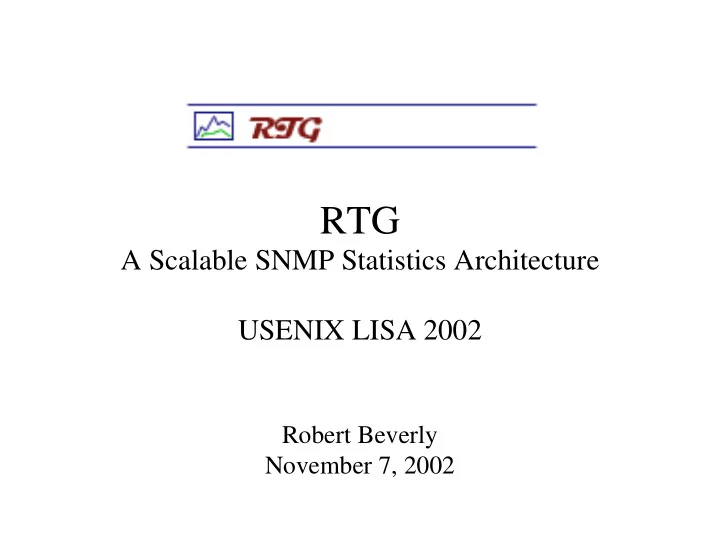

RTG A Scalable SNMP Statistics Architecture USENIX LISA 2002 Robert Beverly November 7, 2002
Overview • Unique problems service providers & large enterprises face gathering statistics • Discuss existing tools and limitations • Introduce RTG – Architecture/features – Sample reports/output • Questions
Background - What’s the Problem • SNMP: Simple Network Mgmt Protocol • Despite “Simple,” Many Issues: – Scaling in Large Installations – Storage Retention (Length/Granularity/Averaging) – Report Generation Time (Interactivity) – Reporting Flexibility – Robustness, statistics as a critical component: • Legal (Culpability) • Billing
Motivation • Large Commercial Service Provider with 100’s of devices, 100’s of interfaces • Other Open-Source packages could not complete polling within 5-minute interval • New requirements to monitor additional per- interface statistics • New reporting requirements
Requirements • Four High-Level Requirements: – Support for 100’s of devices with 1000’s of objects (very high speed) – Ability to retain data indefinitely – Provide an abstract interface to data in order to generate complex and/or custom reports – Disjoined polling and reporting
Solutions • Fix Existing Systems: – No clean separation of polling, reporting makes distributing load difficult – Faster hardware • Commercial Package: – Large, bloated, expensive • MRTG: – Scaling Problems • Cricket + rrdtool: – Good scaling (can we do better?), no abstract data interface • See Paper for Full Comparison/Analysis
RTG: Real Traffic Grabber • Flexible, scalable high-performance SNMP monitoring system • Runs as a daemon on UNIX platforms • Can poll at sub-one-minute intervals • All data inserted into a relational database • Keeps absolute samples, no averaging • Intelligent database schema to retain long-term data without speed degradation • Traffic reports, plots, web-interface • Easily supports distributed polling, data redundancy
RTG Operation • All data is inserted into the MySQL database • Network configuration stored in database • Auxiliary Perl script, “rtgtargmkr.pl” queries network for new interfaces and changed ifIndex or description. • Generates an RTG “target list” • RTG poller, “rtgpoll” randomizes objects in the target list – Limits SNMP query impact on network devices – Improves performance • Reports and Graphs generated via APIs to MySQL (Perl DBI, PHP, C)
RTG Functional Diagram
Database Schema • Non-trivial – Better schemas for different environments – RTG poller is indifferent to schema • Need to retain long-term historical data (ideally indefinitely): – Legal/Billing – Disks are cheap, but keep as little data as possibile • Query execution time should be independent of time period requested: – Generating a report for a day one year ago should be as fast as generating today’s report
Database Schema • Router and Interface tables keep identifiers, descriptions, speeds, etc. • Segment data as much as possible (indexes are great, but require index space) • SQL table per unique device and object – ifInOctets_9 table – Store only date/time, sample and interface • Index each table on date/time
Database Schema
RTG Speed • What makes RTG fast? – Daemon – No cron overhead – Written in C – No interpreter overhead – Multi-threaded: • Keep a constant number of “queries-in-flight” • Exploit Natural Parallelism in Slow I/O • Use multiple processors – Randomized targets: • An unresponsive device does not block all threads
RTG Speed (Some Numbers) App Targets Run Time Targs/sec Max Targs (seconds) MRTG 1618 365.4 4.43 1328 Cricket 2010 87.8 22.89 6868 RTG 3650 34.2 106.73 32018 • Max Targets indicates theoretical maximum number of targets polled in a 5 minute interval
RTG Reports • Perl DBI scripts included • Automate reporting, etc. Traffic Daily Summary Period: [01/01/1979 00:00 to 01/01/1979 23:59] Site GBytes In GBytes Out MaxIn(Mbps) MaxOut AvgIn AvgOut ---------------------------------------------------------------------------- rtr1.someplace: so-5/0/0 384.734 360.857 49.013 43.420 35.630 33.426 so-6/0/0 357.781 421.736 42.923 50.861 33.137 39.053 t1-1/0/0 0.054 0.058 0.005 0.006 0.005 0.005 rtr3.someplace: so-6/0/0 1,115.258 1,246.163 168.776 172.690 103.173 115.439 so-3/0/0 1,142.903 1,028.256 152.232 162.402 105.863 95.142 so-7/0/0 152.824 199.742 22.052 35.005 14.152 18.488
RTG Reports (95 th Percentile) ABC Industries Traffic Period: [01/01/1979 00:00 to 01/31/1979 23:59] RateIn RateOut MaxIn MaxOut 95% In 95% Out Connection Mbps Mbps Mbps Mbps Mbps Mbps ------------------------------------------------------------------------------- at-1/2/0.111 rtr-1.chi 0.09 0.07 0.65 0.22 0.22 0.13 at-1/2/0.113 rtr-1.dca 0.23 0.19 1.66 1.12 0.89 0.57 at-3/2/0.110 rtr-2.bos 0.11 0.16 0.34 0.56 0.26 0.40
RTG Traffic Graphs
RTG Sub-Minute-Polling
RTG Error Graph • rtgplot can plot impulses (errors)
Long-Term Trending • Perl scripts analyze data and produce CSV output that is easily imported into spreadsheets • Ideal for management reports, trending, etc.
Thanks • Questions? RTG Home Page: http://rtg.sf.net
Recommend
More recommend